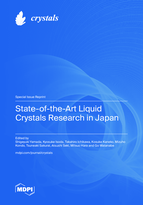State-of-the-Art Liquid Crystals Research in Japan
A special issue of Crystals (ISSN 2073-4352). This special issue belongs to the section "Liquid Crystals".
Deadline for manuscript submissions: closed (31 March 2023) | Viewed by 17634
Special Issue Editors
Interests: organic synthesis; fluorine; liquid crystals; fluorescence; phosphorescence; stimulus-responsive materials
Special Issues, Collections and Topics in MDPI journals
Interests: N-heteroacene; room-temperature liquid; stimuli-responsive liquid; liquid crystal; fluorescence
Interests: gyroid; liquid crystals; ionic liquids; bicontinuous cubic phase; ion conduction; polymer film
Interests: liquid crystals; electrorheology; elastomer; siloxane
Special Issues, Collections and Topics in MDPI journals
Interests: liquid crystals; fluorescence; mechanochromism; polymer
Special Issues, Collections and Topics in MDPI journals
Interests: liquid crystals; supramolecular chemistry; conjugated polymers; organic luminophores; organic semiconductors; nanomaterials
Interests: liquid-crystalline semiconductors; low-molecular-weight gelators; supramolecular ferroelectrics; stimuli-responsive materials
Interests: liquid crystalline polymer; organic-inorganic hybrid; surfactant; alignment control
Special Issue Information
Dear Colleagues,
Liquid crystals (LCs) are substances that have liquid properties (fluidity) and exhibits the optical anisotropy of crystals, and exhibits properties intermediate between crystals and liquids. LC molecules mainly consist of a rigid π structure and a flexible chain unit, which maintain some directional order (orientation), but do not have positional order. With a thermotropic or a lyotropic phase-transitions between crystal ⇄ LC ⇄ liquid, the molecular aggregates could be reversibly arranged and be expected by molecular dynamic simulations. The alteration of molecular aggregates is well known to significantly affect to various physical behavior, in the photophysical, optical, electrical, and chemical aspects. Therefore, there is no doubt that consolidating the results of cutting-edge liquid crystal research into a single special issue will greatly contribute to the future development of the fields of chemistry, materials, optics, and electronics.
This special issue, titled “State-of-the-Art Liquid Crystals Research in Japan” is intended to provide an innovative and broad perspective on the LC researches in Japan in the field of chemistry, physics, optics, photonics, photo-alignment techniques, material and devices, and others.
The potential topics include, but are not limited to:
- Exploration of novel LC materials
- Development of functional materials with LC characteristics
- Characterization of the structures for LC phases
- Exploration of simulation techniques for LC materials
- Applications using LC materials
Prof. Dr. Shigeyuki Yamada
Prof. Dr. Kyosuke Isoda
Prof. Dr. Takahiro Ichikawa
Prof. Dr. Kosuke Kaneko
Prof. Dr. Mizuho Kondo
Prof. Dr. Tsuneaki Sakurai
Prof. Dr. Atsushi Seki
Prof. Dr. Mitsuo Hara
Prof. Dr. Go Watanabe
Guest Editors
Manuscript Submission Information
Manuscripts should be submitted online at www.mdpi.com by registering and logging in to this website. Once you are registered, click here to go to the submission form. Manuscripts can be submitted until the deadline. All submissions that pass pre-check are peer-reviewed. Accepted papers will be published continuously in the journal (as soon as accepted) and will be listed together on the special issue website. Research articles, review articles as well as short communications are invited. For planned papers, a title and short abstract (about 100 words) can be sent to the Editorial Office for announcement on this website.
Submitted manuscripts should not have been published previously, nor be under consideration for publication elsewhere (except conference proceedings papers). All manuscripts are thoroughly refereed through a single-blind peer-review process. A guide for authors and other relevant information for submission of manuscripts is available on the Instructions for Authors page. Crystals is an international peer-reviewed open access monthly journal published by MDPI.
Please visit the Instructions for Authors page before submitting a manuscript. The Article Processing Charge (APC) for publication in this open access journal is 2600 CHF (Swiss Francs). Submitted papers should be well formatted and use good English. Authors may use MDPI's English editing service prior to publication or during author revisions.
Keywords
- Liquid crystals
- Blue-phase
- Stimulus-responsive
- Photoalignment control
- Molecular dynamic simulations
- Rheology
- X-ray diffraction
- Luminescence
- Electrical conductivity














